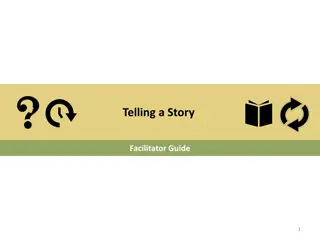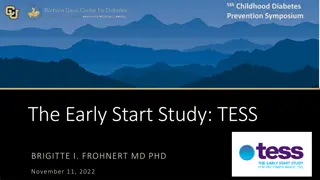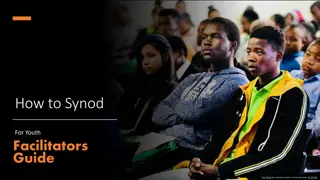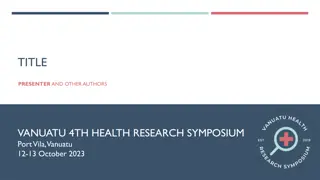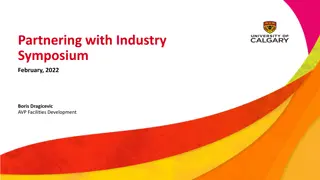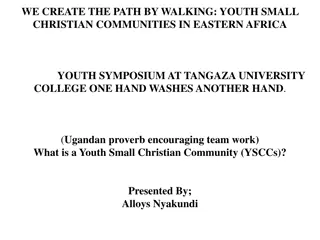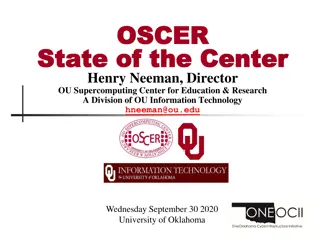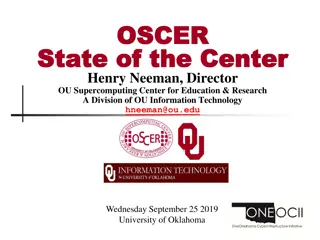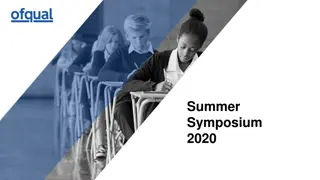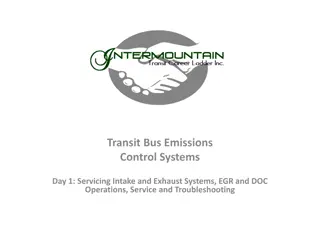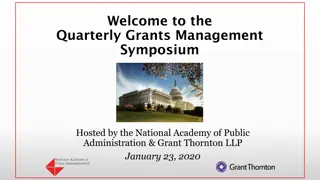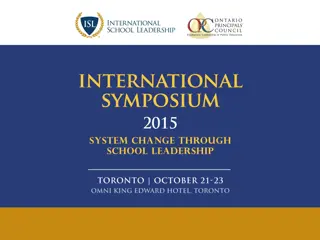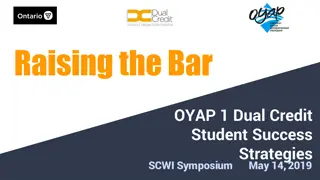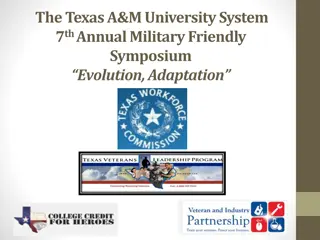Reading Symposium Facilitator Guide for Successful EGR Implementation
This PowerPoint presentation, supported by USAID, provides a comprehensive facilitator guide for a Reading Symposium aimed at celebrating, learning, adapting, and adopting successful Early Grade Reading (EGR) strategies. The guide covers session organization, introductions, and opening remarks essential for a successful event. It emphasizes engaging participants and setting the tone for a productive workshop dedicated to advancing EGR programs.
Download Presentation

Please find below an Image/Link to download the presentation.
The content on the website is provided AS IS for your information and personal use only. It may not be sold, licensed, or shared on other websites without obtaining consent from the author.If you encounter any issues during the download, it is possible that the publisher has removed the file from their server.
You are allowed to download the files provided on this website for personal or commercial use, subject to the condition that they are used lawfully. All files are the property of their respective owners.
The content on the website is provided AS IS for your information and personal use only. It may not be sold, licensed, or shared on other websites without obtaining consent from the author.
E N D
Presentation Transcript
Reading Symposium FACILITATOR GUIDE Celebrate, Learn, Adapt and Adopt EGR Success This PowerPoint presentation is made possible by the support of the American people through the United States Agency for International Development (USAID). The contents are the responsibility of RTI International and do not necessarily reflect the views of USAID or the United States Government
Session: Registration and Morning Tea Objective: Create a welcome introduction and have engaging audio-visual while people wait Time: 30 minutes Preparation Registration forms Pre-printed colored labels Packages Venue (African) larger room with space for central presentation and groups. 3-4 separate feeding lines: Room set up main U- shape around front with six work stations behind; Night before Checklist: Set up data station, EGRA demonstration or Papaya in am, working group for am set up, agenda displayed, banners, posters, data packs, registration table. IT: Set up data station (Tablet and Papaya). Sound check, Projector set up, line up reading campaign items. Test videos - bright spots, reading campaign Managing this session: Honor people who have arrived on time. On registration, participants receive a name tag with color coding with their name and a package that includes: Learning journal; data package, At-a-glance, Briefer Tablet and Papaya technology demonstration station Posters (from data set) Banners Remind participants are welcomed; walk around; greet each other, watch reading campaign materials 2
Session: Introduction Objective: To create excitement and interest in content and process Time: 30 minutes Managing this session: MC/facilitator moves the sets the tone for the meeting, beginning with a lively coverage of the protocol items for opening the workshop. Step 1: Invites pre-assigned person to lead the group in the singing of the national and East Africa anthems; Step 2: Introduction by institution and titles, mention the importance of their attendance to achieve the objectives of the workshop and around their engagement to determine future priorities. Thanking them for their time given the responsibilities of their jobs and recognizing the value of their time. Step 3: Review of mini-lab process and purpose of the Reading Symposium Dr. Lusambu, Commissioner of Basic Education (prepare small presentations) Step 4: Agenda for Reading Symposium (MC) Preparation: Brief MC Pre nominate someone to start 1 stanza of each anthem; another set to complete prayer; Presentation (slide) on Mini-lab process Presentation on Purpose of Reading Symposium Note: Provide talking points on mini-lab and purpose of the Reading Symposium Provide talking points to speakers that include objectives of the day IT: At least one stand with access to power (extension cord) Ensure microphones working and 2 people assigned to moving them around the room - 3
Time: :20 minutes Session: Welcome and Opening Remarks Objective: To legitimize the mini-lab process as a mechanism to review EGR program Managing this session: Step 1: Step 2: Step 3: Step 4: Step 5: Step 6: Step 7: Preparation: Introduction of PS Permanent Secretary Welcome and opening remarks Introduction to the Minister of State Remarks of the Minister of State Introduction of the USAID Mission Director (MC) USAID Mission Director To learn to read is to light a fire Escort of PS and Minister of State to media interaction Talking points for PS, Minister of State Talking points for USAID Mission Director Material package for media, set up of a media station for interaction IT: At least one stand with access to power (extension cord) 4
Time: 15 minutes for Video and plus 15 minutes Session: Introductory Animated Film Objective: To visualize the essential components of a EGR and the link to education performance Managing this session Step 1: Introduce the session by saying that participants will view a 5 minute video reminding us of the core elements of a successful reading strategy. Step 2: You will show a 5 minute video. Ask participants if they can see the screen, then start the video. Step 3: Once the video has finished, summarize session Preparation: Arrange seating such that all can see the screen. IT: Test Video the night before, confirm audio sound system is functioning and the commentary is audible, make sure there is a large enough screen to project the video film. 5
Session: Learning Highlights from District Engagement Meeting Objective: to reflect on district implementation of EGR initiatives that may sustain EGR learning outcomes Time: 10 minutes Managing this session: Step 1: Step 2: Step 3: Step 4: generated in stakeholders engagement is informing the design and content of the Reading Symposium. Preparation: Introduction of CAO Luwero (MC) and define bright spot ideas worth sharing CAO Present Slide show (Brenda) with music Summary of session (MC) - only 10 minute session need to note that data Review with guest speaker content of presentation and timing, help with test run if required to confirm timing. Slide show with music IT: Test slide show night before, if microphones are needed then get them moving in the room and powered up. 6
Time:50 minutes -7 minutes per group Session: Poster Sessions Objective: To use data to inform discussion around priorities Managing this session: Step 1: one group and when they hear a bell they move to the next session. They will be introduced to six data poster sessions. The host at each group has a colored flag, the participants are instructed to start with the flag presented. After 7 minutes a bell will be sounded and they are to follow the flag to the next post. Step 2: Each host has a pre-defined process. Host states the we want to look at the data to inform discussion and generate ideas to inform practice. The following questions are prompting questions only not a required script - What does this data tell you? The host can help the group interpret by ask leading questions . what does this data show , KEY POINT: Give participants time to look at the graphs. They are trying to make meaning for themselves but be helpful with tips like - the light blue representing control the dark are schools with an intervention. Step 3: Concluding How would you answer the question .. based on this data? How do you feel about that? Step 4: Co-host walks with the flag to the next station. Discuss the night before roles and routes of flag bearers Step 5: Bring all together. MC states before we go on break, would anyone like to share anything that moved you that you want to share with the group. Poster 1: Are Uganda children learning how to read effectively? Poster 2: Do we have quality early grade reading instruction? Poster 3: Are teachers supported in early grade reading instruction? Poster 4: Are primary schools positive and supportive for teaching and learning Poster 5: What can we do to improve access to quality teacher guides and pupil books? Poster 6: Is there clear performance monitoring and accountability? Provide overview of session. Participants will start in Preparation: Arrange gallery walk in the room, seating such that all can see the posters, ensure data posters are printed and posted. Create flags (make flags and get flag bearers) and music. Select and prepare hosts for each station 7
Time: 20 minutes (10 presentation, 7 film) Session: International and Local Best Practice in Teacher Professional Development Objective: To use data to inform discussion and prioritization of a way forward. Managing this session: Preparation: Step 1: Step 2: Step 3: Step 4: starting point and then move to the right. Have 45 minutes in each group and will get instructions. Step 5: Transition participants into their groups, explain the use of the bell to end the session and the importance of moving to the next station quickly. a. Participants will notice that their name badge is color coded. They are requested to form groups with similar colors. b. Participants will notice the same color over each work station. They are requested to begin at the similar color work station and then rotate to the right. Introduction to speaker Speaker - Dr. Ben Piper IT starts the video (Bright Spot on Kyegegwa) Provide instructions for group work and move them into the groups: color IT: Microphone check if audience is commenting, pretest video before and get ready. 8
Group 1: Pre-Service Training Objective: To understand how better to integrate early grade reading into pre-service curriculum Time: 45 minutes Managing the session: Facilitator 1) introduce the topic and describe process Over the 45 minutes, we are going to discuss is being done to ensure EGR is incorporated into pre-service training and aligned to in-service teacher support. We are going to discuss our current progress, identify and prioritize steps forward to incorporate EGR into pre-service training, and brainstorm the complications /challenges taking these steps forward. 2) Show Wakiso bright spot video Ask the first question (give 10 minutes) make sure they talk about the addendum as an add on (not incorporated into the curriculum (August, 2017) and what progress have been made over the year? Think pair-share 3) then say Given where we are, what are the next steps forward (Question 2). Let them talk for 15 minutes. The notetaker is identifying steps and making sure there is a card for every step (some will already be on the cards, and some new cards may be generating). The cards are displayed on the wall in front of the group. Step 4) Facilitator explain how to vote and give people 5 minutes to journal their priorities and then decide where to place their sticker. Step 5) Now inform participants that you want to ask the final question, (tone and delivery reflection and pacing), I want you to close your eyes and think deeply about the issue and identify one thing that you feel is absolutely critical just one thing . We are just going to create a brainstorm list Steps Forward: 1. Standardize EGR course unit examinable subject 2. Reading pedagogy mandatory for all primary grades 3. Evaluation tools for school practice 4. Exam reading in local language 5. Process for evaluating and revising curriculum 6. Other suggestions Preparation: Steps forward written on cards, voting dots/person, pre- identified barriers. RTI Indonesia data check. Space needs to organized in small groups, with escorts from one group. Need 3 sets of materials person taking notes takes a picture and then reuse cards Barriers: Leading Question: 1. What has been done to ensure that early grade reading is being implemented in the delivery of the Primary Teacher Education curriculum? 2. What are the steps forward? (Steps Forward Box lists points for Facilitator if not raised in discussion) 3. What challenges might be faced in moving these steps forward? (Barriers Box lists points for Facilitator if not raised in discussion) 1. 2. Organizational culture Local Language representation Local Language and English fluency Coordination and placement of school practice Insufficient number of pre- service tutors EGR capacity of pre- service tutors others Summary Points: Teaching reading needs to be mandatory for primary teachers EGR needs to be part of the Teacher Education Curriculum 3. 4. 5. 6. Data: USAID. Syntheses of Finding and Lessons Learned from USAID-Funded Evaluations. Education Sector, 2013-2016. January 24, 2018. Page 17. 7. 9
Time: 45 minutes Group 2: In-service teacher professional development Objective: To understand teacher professional growth and development in relation to EGR outcomes Steps Forward Residential training at Colleges Champion Teachers Peer to Peer (school- level) Structured CPD for teachers at Coordinating Center Level School level CPD for teachers Zonal level CPD for head teachers Other suggestions 1. Managing the session: Facilitator 1) introduce the topic and describe process Over the 45 minutes, we are going to discuss what is being done to provide teacher continuous professional growth and development in relation to EGR outcomes. We are going to discuss our current progress, identify and prioritize steps forward to incorporate EGR into in- service continuous professional growth and development, and brainstorm the complications /challenges taking these steps forward. 2) Show video (Kyegegwa), ask What have you observed from this video about teacher professional growth and development , take a minute to write your reflection in your journal (wait 1 minute) ask for volunteer to share their thoughts. Step 3 - Ask the first question (give 10 minutes) make sure they talk about the addendum as an add on (not incorporated into the curriculum (August, 2017) and what progress have been made over the year? Think pair-share 3) then say Given where we are, what are the next steps forward (Question 2). Let them talk for 15 minutes. The note taker is identifying steps and making sure there is a card for every step (some will already be on the cards, and some new cards may be generating). The cards are displayed on the wall in front of the group. Step 4) Facilitator explain how to vote and give people 5 minutes to journal their priorities and then decide where to place their sticker. Step 5) Now inform participants that you want to ask the final question, (tone and delivery reflection and pacing), I want you to close your eyes and think deeply about the issuer and identify one thing that you feel is absolutely critical just one thing . We are just going to create a brainstorm list 2. 3. 4. Preparation: Projector, video set up, steps forward on cards, voting does/person, pre-identified barriers. Poster on use of teachers guides, RTI data on teacher uptake of EGR. Space needs to organized in small groups, with escorts from one group. 5. 6. 7. Barriers Organizational culture and maintain status quo Holding pedagogical leaders and teachers accountable for professional development EMIS for professional development Promotion not linked to professional development Synergy between college and district professional development Synergy between needs and content Competing priorities of CCT EGR capacity of CCT, inspectors Language skills of CCT tutors 10. Deterioration of Coordinating Center 1. 2. 3. Summary Points: Continuous investment in teachers growth and development Training is not enough Holist approach to CPD 4. Leading Question: 1. What has been done in providing teacher professional growth and development to ensure quality early grade reading instruction? 2. What are the steps forward? 3. What challenges might be faced in moving these steps forward? 5. 6. 7. 8. Data: RTI Teacher Guides, Quality of teaching, Teacher s Perception of Supported 9. 10
Group 3: Support to Teachers and Schools Objective: To recognize that instructional support leads to quality instruction and improved reading outcomes Time: 45 minutes Steps Forward 1. Restructure channels of support 2. Synergy between district and college 3. District budgets integrate EGR instruction and supervision 4. Pilot cost-effective alternatives for instructional support 5. Caring and constructive approaches 6. Transport allowance amount linked to quality instructional support 7. Articulate guidelines for incorporating EGR in support supervision tools (DES) 8. Other suggestions Managing the session:Facilitator 1) introduce the topic and describe process Over the 45 minutes, we are going to discuss what is being done to provide teachers with constructive instructional support. We are going to discuss our current progress, identify and prioritize steps forward to ensure teacher obtains quality instructional support, and brainstorm the complications /challenges taking these steps forward. 2) Ask the first question (give 10 minutes) make sure they talk about poster session. Think pair-share 3) then say Given where we are, what are the next steps forward (Question 2). Let them talk for 15 minutes. The note taker is identifying steps and making sure there is a card for every step (some will already be on the cards, and some new cards may be generating). The cards are displayed on the wall in front of the group. Step 4) Facilitator explain how to vote and give people 5 minutes to journal their priorities and then decide where to place their sticker. Step 5) Now inform participants that you want to ask the final question, (tone and delivery reflection and pacing), I want you to close your eyes and think deeply about the issuer and identify one thing that you feel is absolutely critical just one thing . We are just going to create a brainstorm list Preparation: Projector, video set up, steps forward on cards, voting does/person, pre- identified barriers. Poster on use of teachers guides, RTI data on teacher uptake of EGR. Space needs to organized in small groups, with escorts from one group. Leading Question: 1. What has been done in providing teachers with instructional support to ensure quality early grade reading instruction? Summary Points: Teacher with instructional support lead to better reading outcome Teacher s Guide content and structure improve EGR instructions Quality of coaching (caring, positive and constructive) matter Barriers 1. Multiple and competing roles of CCT and inspectors 2. Inclusion of EGR in coaching (MSS) tools 3. Inspection mentality 4. Insufficient personnel 5. Amount and timing of transport funds 6. Political interference 7. others 2. What are the steps forward? 3. Data: RTI and GPE MSS data, RTI Coaching Data, RTI Teachers Guide Data What challenges might be faced in moving these steps forward? 11
Session: International and Local Best Practice in Performance Monitoring and Accountability Objective: To use data to inform discussion and prioritization of a way forward Time: 15 minutes Managing this session: Preparation: Step 1: Step 2: Step 3: Step 4: instructions for group work and move them into the groups: color starting point and them move in to right Have 40 minutes in each group and will get instructions. Introduction to Speaker 1: Joe Destefano on Bare Bones Speaker the intersection between performance expectations, monitoring and service delivery. Question and Answer with audience Move the group: MC introduces the three parallel sessions and the instructions for group work. Provide Brief speaker IT: Microphone check if audience is commenting, pretest video before and get ready. 12
Time: 40 minutes for each of the group sessions; then we rotate groups Group 4: School Climate Objective: A positive and supportive learning climate leads to improved learning outcomes Steps Forward: Ensure teaching aids, pupil books, teacher guides are available Recognize and care about teachers No tolerance policy for bullying, corporal punishment and sexual harassment Ensure all pupils are treated equally and their learning needs recognized and addressed Ensure attention to school- community relations Managing the session: Step 1: Facilitator introduce the topic and describe process Over the 45 minutes, we are going to discuss what is being done to create a positive and supportive school climate for teachers and students. We are going to draw a mind-map, this is a technique used to visualize complex issues, and then from there we will identify and prioritize steps forward to enhance the learning and teaching environment, and brainstorm the complications /challenges taking these steps forward. Step 2: Mind Map what constitutes a positive and supportive learning climate for teachers and learners . Put key question in the middle and then add element of school climate (pre prepared, adding new) as they arise and write all issues that arise related to the element (15 minutes). Ask volunteers What is this map telling you? Step 3: Ask question 2. Let them talk for 15 minutes. The note taker is identifying steps and making sure there is a card for every step (some will already be on the cards, and some new cards may be generating). The cards are displayed on the wall in front of the group. Step 4: Facilitator explain how to vote and give people 5 minutes to journal their priorities and then decide where to place their sticker. Step 5:Now inform participants that you want to ask the final question, think the issuer and identify one thing that you feel is absolutely critical think pair-share one thing . We are just going to create a brainstorm list 1. Preparation: Semi-pre populated mind map, steps forward on cards, voting does/person, pre-identified barriers. Poster on use of teachers guides, RTI data on teacher uptake of EGR. Space needs to organized in small groups, with escorts from one group. 2. 3. 4. 5. Barriers: 1. 2. Social and cultural norms Failure to link educational outcomes with quality of school climate Prevalence of all forms of violence Weak social contract between school and community High classroom size and teacher: pupil ratio Teacher and pupil absenteeism Leading Question: 1. What constitutes a positive and supportive learning climate for teachers and learners? 3. Summary Points: 2. What are the steps forward? 4. 3. Data: Teacher and pupil well being, Pupils Safety, Heart poster, teacher absenteeism data, pupil attendance, Availability of Teaching and Learning Materials, Inclusive for children with disabilities What challenges might be faced in moving these steps forward? 5. 6. 13
Group 5: Teaching and Learning Materials for Early Grade Reading Objective: To understand the importance of TLMs to increasing reading achievement, to guide efforts to ensure that materials are present and continue to meet the needs of teachers and learners Time: 45 minutes Steps Forward 1. Planning for materials replacement 2. Ensuring materials are being used properly and repaired 3. Revise Teacher Guides 4. Revise Pupil Books 5. Replenish Teacher Guides 6. Replenish Pupil Books 7. Replenish and increase supplemental reading materials Managing the session: Step 1: Facilitator introduce the topic and describes process Over the 45 minutes, we are going to discuss teaching and learning materials crucial to increasing reading achievement namely the EGR teacher guide, the pupil books and other supplemental materials that have been found to be useful in providing learners with exposure to reading and print. We are going to draw a mind-map, this is a technique used to visualize complex issues, and then from there we will identify and prioritize steps forward to enhance the availability, quality and use of these materials and brainstorm the complications /challenges taking these steps forward. Emphasize that while there may be small issues in one particular language or class guide or book, we are not discussing those small issues today. We would like to focus on the systems that ensure materials are high quality, available and used properly in the classroom. Step 2: Mind Map think about how you have seen materials used (or not used) in reading lessons. Can you think of an ideal situation? Put key question in the middle and then add element of TLMs as they arise and write all issues that arise related to the element (15 minutes). Ask volunteers What is this map telling you? Step 3: Ask question 2. Let them talk for 15 minutes. The note taker is identifying steps and making sure there is a card for every step (some will already be on the cards, and some new cards may be generating). The cards are displayed on the wall in front of the group. Step 4: Facilitator explain how to vote and give people 5 minutes to journal their priorities and then decide where to place their sticker. Step 5:Now inform participants that you want to ask the final question, think the issuer and identify one thing that you feel is absolutely critical think pair-share one thing . We are just going to create a brainstorm list Preparation: Projector, video set up, steps forward on cards, voting. Barriers Summary Points: Teacher guides ARE the teaching methodology and need to be present and properly utilized. Pupils need an accompanying book in their hands MoES needs to budget for book replacement and process for making revisions Insufficient budget for EGR TGs and pupil books Teacher guides complex, difficult to use Books not being used properly (open on desks while learners chanting from the board or memory). Lack of clarity on material revision process Leading Question: 1. What is the current status of the teaching guides, pupil books, instructional materials and their use 2. What are the steps forward? 3. What challenges might be faced in moving these steps forward? Data: RTI and GPE MSS data, RTI Coaching Data, RTI Teachers Guide Data 14
Group 6: Performance Monitoring and Accountability Objective: To understand the link between expectations, monitoring and support. Time: 40 minutes Managing the session: Step 1: Facilitator introduce the topic and describe process Over the 40 minutes, we are going to discuss different aspects of core functions model presented by Joe DeStefano. We are going to give you a chance to consider steps forward in setting and communicating expectations, monitoring and accountability related to literacy instruction. Step 2. The Facilitator presents on a flipchart paper the Core Functions Model that was discussed. The facilitator reviews the three elements of this model. Step 3. Ask participants to turn to join two neighbors and make a group of three. Give each group one sticky note. Point to the Setting Expectations element of the model. Ask the groups, How does the Uganda sector set reading performance expectations and how do they communicate these expectations? Write this down on the sticky note. When they have finished ask a representative from each group to state what they wrote and place the sticky note on the model under Setting Expectations. Step 4. Ask participants to break up into three groups. One is assigned to national, another to district and another to school. The facilitator points to the Performance Monitoring element of the model. Ask the groups, How does the education sector monitor early grade reading performance at the national, district and school level? Give groups 3 minutes to discuss how EGR performance is monitored at their assigned level and write this. Each groups shares what they wrote and posts their sticky note on the Monitoring component of the model. Step 5. Ask for volunteers to mention how this monitoring data is used to inform school support and hold districts and schools accountable for performance. Step 6: Ask groups to take 10 minutes to answer question 2, What are the steps forward? The note taker is identifying steps and making sure there is a card for every step forward that is mentioned. (Some will already be on the cards, and some new cards may be generated). The cards are displayed on the wall. Step 7: Now inform participants that you want to ask the final question, think of steps forward and identify one thing that you feel would get in the way with the steps forward that were mentioned. Leading Question: 1. How does the education sector set reading performance expectations, how do they communicate these expectation, monitor performance and hold system accountable? 2. What are the steps forward? 3. What challenges might be faced in moving these steps forward? Steps Forward Create reading benchmarks or grade-level targets Monitoring, Learning and Assessment includes reading in local language for early grade Create district performance profiles - Lot Quality Assurance Sampling (LQAS) Strengthening the use date in district and national planning and performance discussions Holding districts and schools accountable Other suggestions 1. 2. Preparation 3. Bare Bones Model Materials: Post-it notes 4. 5. 6. Barriers 1. Limited representative district level reading performance data Commercialization of examination Limited use of data to improve learning, inform decisions and resource allocations Limited link between career advancement and performance Inability to implement rewards and sanctions Political interference others 2. 3. Summary Points 4. 5. 6. 7. 15
Session: Voting on Priorities Outcome: To measure the importance of each priority to the participants Time: 10 minutes Managing this session: Step 1: hand out equipment Step 2: Step 3: Step 4: Step 5: inform the Reflection Retreat. Preparation: Prepare power point with questions, decide bar graph or pie chart Ensure there are facilitators with microphones to carry to each table. Facilitator describe the voting activity and describes of how they work (Emma), Have a test run what is your favorite fruit? give five choices Introduce the first question, repeat for six questions Collect how to do that quickly and account for them. Thank for voting and commenting overall on how these priorities will be used to Same facilitator needs to ready to reclaim microphone when 2 minutes is up. IT: Hand out voting machines, have question formulated and loaded, and presentation of real-time voting. Test in advance 16
Time: 10 minutes Session: Closing Managing this session: Step 1: Step 2: Preparation: MC Introduction to speaker Speaker Closing remarks to Ministry 17
Thank you 18


